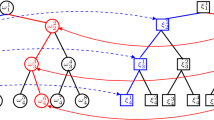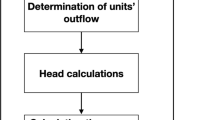Abstract
The high penetration of wind generation has prompted the development of stochastic hydrothermal unit commitment (SHTUC) models, which are more difficult to be solved than their thermal-based counterparts due to hydro generation constraints and inflow uncertainties. For handling the uncertainty, the problem is usually formulated as a two-stage stochastic model (2S-SHTUC), although multistage (MS-SHTUC) formulations have gained increasing attention due to their more realistic assumptions about on–off decisions over the planning horizon. Benders decomposition (BD) is one of the most common methodologies used for solving 2S-SHTUC and MS-SHTUC problems. To overcome the well-known slow convergence of the classical BD when applied to large problems, most authors use accelerating techniques. In this paper, we implement state-of-the-art stabilization methods tailored for speeding up the convergence of the classical BD: local branching and the level regularization. Our experiments are conducted in a real-life SHTUC problem with 11 thermal units, 16 hydro plants, 46 buses and 95 lines. The results show that 2S and MS-SHTUC can benefit from stabilization. The savings in computing times range from 69 to 95% for the 2S-SHTUC model and from 77 to 89% for the MS-SHTUC.
















Similar content being viewed by others
Notes
We attempted to solve the deterministic equivalent of the cases without decomposition with a 1% gap and a 24 h time-limit. In our tests, Gurobi was not able to find a feasible solution to any instance.
We assume a zero cost when the current master problem’s solution is not feasible in the SP.
Abbreviations
- Ns, Mp :
-
Nodes in the subproblem/master problem tree
- \({\mathcal{L}}\) :
-
Leaf nodes
- \({\mathcal{P}}^{n}\) :
-
Set of nodes in the path of node n
- G, H :
-
Thermal and hydro plants
- UR h :
-
Hydro plants upstream of plant h
- HP h :
-
Hydro production function of plant h
- E :
-
Future cost function
- B, TL :
-
Buses and transmission lines
- n, m :
-
Node in the subproblem/master problem tree
- o :
-
Auxiliary index for nodes
- l :
-
Leaf node
- \(n_{n}^{ - } ,\;m_{m}^{ - }\) :
-
Parent nodes of nodes n and m
- g, h, w :
-
Thermal, hydro and wind plant
- u :
-
Auxiliary index for hydro plants
- b, j :
-
Indices for buses
- tl:
-
Transmission line
- tg g,n, z g,m, a g,m, b g,m :
-
Generation at node n, status, start-up and shut-down decision of thermal plant g at node m
- hg h,n, v h,n, q h,n, s h,n :
-
Generation, volume, turbine discharge and spillage of hydro h at node n
- \(\delta_{b,n}^{ + }\), \(\delta_{b,n}^{ - }\) :
-
Deficit and surplus at bus b and node n
- ω l :
-
Expected operation cost at leaf node l
- θ b ,n :
-
Voltage angle at bus b and node n
- CV g, UC g, DC g :
-
Variable, start-up and shut-down cost of thermal g
- \(\overline{{\mathbf{R}}}_{g}\), \(\underline{{\mathbf{R}}}_{g}\) :
-
Ramp-up/down rate limit of thermal unit g
- \(\overline{{{\mathbf{TG}}}}_{g}\), \(\underline{{{\mathbf{TG}}}}_{g}\) :
-
Generation limits of thermal unit g
- SU g, SD g :
-
Start-up/shut-down generation requirement of thermal unit g
- TU g, TD g :
-
Minimum-up and down-times of unit g
- A G :
-
Generator-bus incidence matrix
- A h,n :
-
Inflow realization to hydro plant h at node n
- \(\overline{{\mathbf{V}}}_{h}\), \(\underline{{\mathbf{V}}}_{h}\) :
-
Bounds on reservoir volume of plant h
- \(\overline{{\mathbf{Q}}}_{h}\), \(\overline{{\mathbf{S}}}_{h}\) :
-
Maximum turbined outflow (spillage) of plant h
- C x h,i :
-
Constant x (0,…,3) of constraint i of the piecewise linear production function of hydro h
- K h,i :
-
Constant of plant h in i-th linear constraint of the future cost function
- R i :
-
Right-hand side of the i-th linear constraint of the future cost function
- A H :
-
Hydro plant-bus incidence matrix
- D u,h :
-
Water travel time from plant u to h
- P n :
-
Absolute probability of node n
- CS :
-
Unitary cost of deficit and generation surplus
- T n :
-
Time associated with node n
- WG w,n :
-
Wind generation of wind farm w at node n
- A W :
-
Wind farm-bus incidence matrix
- \({\mathbf{L}}_{b,n}^{{}}\) :
-
Load at bus b and node n
- \({\mathbf{B}}\) :
-
Susceptance matrix
- A TL :
-
Transmission line-bus incidence matrix
- \(\underline{{{\mathbf{TL}}}}_{t,l}\), \(\overline{{{\mathbf{TL}}}}_{t,l}\) :
-
Transmission limits of line tl
References
Zheng QP, Wang J, Liu AL (2015) Stochastic optimization for unit commitment—a review. IEEE Trans Power Syst 30(4):1913–1924
Tahanan M, Van Ackooij W, Frangioni A, Lacalandra F (2015) Large-scale unit commitment under uncertainty. 4OR 13(2):115–171
van Ackooij W, Danti Lopez I, Frangioni A, Lacalandra F, Tahanan M (2018) Large-scale unit commitment under uncertainty: an updated literature survey. University of Pisa, Pisa
Abujarad SY, Mustafa MW, Jamian JJ (2017) Recent approaches of unit commitment in the presence of intermittent renewable energy resources: a review. Renew Sustain Energy Rev 70:215–223
Ruiz PA, Philbrick CR, Zak E, Cheung KW, Sauer PW (2009) Uncertainty management in the unit commitment problem. IEEE Trans Power Syst 24(2):642–651
Wen Y, Guo C, Pandžić H, Kirschen DS (2016) Enhanced security-constrained unit commitment with emerging utility-scale energy storage. IEEE Trans power Syst 31(1):652–662
Che P, Tang L, Wang J (2018) Two-stage minimax stochastic unit commitment. IET Gener Transm Distrib 12(4):947–956
Zhang Y, Wang J, Ding T, Wang X (2017) Conditional value at risk-based stochastic unit commitment considering the uncertainty of wind power generation. IET Gener Transm Distrib 12(2):482–489
Wu L (2013) An improved decomposition framework for accelerating LSF and BD based methods for network-constrained UC problems. IEEE Trans Power Syst 28(4):3977–3986
Wu L, Shahidehpour M (2010) Accelerating the Benders decomposition for network-constrained unit commitment problems. Energy Syst 1(3):339–376
Sifuentes WS, Vargas A (2007) Hydrothermal scheduling using benders decomposition: accelerating techniques. IEEE Trans Power Syst 22(3):1351–1359
Wang J, Wang J, Liu C, Ruiz JP (2013) Stochastic unit commitment with sub-hourly dispatch constraints. Appl Energy 105:418–422
Xiong P, Jirutitijaroen P (2011) Stochastic unit commitment using multi-cut decomposition algorithm with partial aggregation. In: Power and energy society general meeting, 2011 IEEE, pp 1–8
Skar C, Doorman G, Tomasgard A (2014) Large-scale power system planning using enhanced Benders decomposition. In: Power systems computation conference (PSCC), pp 1–7
Huang Y, Zheng QP, Wang J (2014) Two-stage stochastic unit commitment model including non-generation resources with conditional value-at-risk constraints. Electr Power Syst Res 116:427–438
Rahmaniani R, Crainic TG, Gendreau M, Rei W (2017) The Benders decomposition algorithm: a literature review. Eur J Oper Res 259(3):801–817
van Ackooij W, Frangioni A, de Oliveira W (2016) Inexact stabilized Benders’ decomposition approaches with application to chance-constrained problems with finite support. Comput. Optim. Appl. 65:637–669
Fischetti M, Lodi A (2003) Local branching. Math Program 98(1–3):23–47
Birge JR, Louveaux F (2011) Introduction to stochastic programming. Springer, Berlin
Author information
Authors and Affiliations
Corresponding author
Rights and permissions
About this article
Cite this article
Colonetti, B., Finardi, E.C. Stochastic hydrothermal unit commitment models via stabilized benders decomposition. Electr Eng 103, 2197–2211 (2021). https://doi.org/10.1007/s00202-020-01206-0
Received:
Accepted:
Published:
Issue Date:
DOI: https://doi.org/10.1007/s00202-020-01206-0




